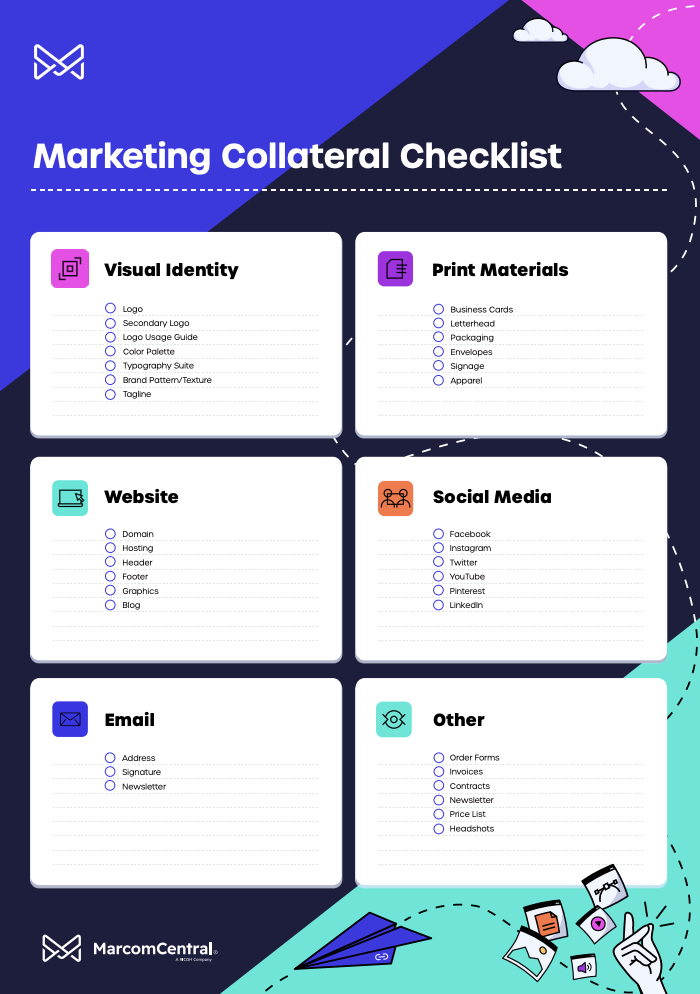- Table of Contents:
- What is an Asset
- What is a Marketing Collateral Audit
- How Often Should You Do an Audit
- 5 Keys to Performing a Successful Collateral Audit
Get news, updates, and insights delivered straight to your inbox.
How to Do a Marketing Collateral Audit (with Checklist)

In the multichannel marketing landscape of today, numerous materials are necessary to represent a single brand. This marketing collateral may be used for blog posts, email campaigns, web pages, social media, and other outlets — and it all is stored safely away in your digital asset management (DAM) solution. But when was the last time you or your company took stock of your collections? Making regular collateral audits part of your marketing strategy can help identify outdated files, make room for fresh ones, and better position your team to provide premium service to your clients.
What Is an Asset in Marketing? A Complete Marketing Collateral Checklist
In marketing, an asset is anything you use to promote a brand, product, or service. From print materials to multimedia content, there’s a multitude of different assets in your collections. Common marketing assets for a company brand may include two different categories of assets:
1. Simple Marketing Assets:
Images
Images are one of the most basic forms of marketing collateral. They can include real-world photographs, animated content, charts, graphs, or any other visual aid that helps drive home your messaging, break up long segments of content, and keep readers intrigued.
Videos
If a picture is worth a thousand words, how many words could a video be worth? Video-based content is one of the most powerful types of marketing collateral, so if you want to make a lasting impact on your target audience, make a great video. Doing so is a surefire way to reach a broader audience.
Animations
Animations are a fantastic way of capturing an audience’s attention and keeping it long enough to convey your message. Animations are usually gif format and they contain a few images put together to convey a short presentation
Animation is also a great tool for creating explainer videos, which, as their name implies, explain what your product does, how it works, and who it is made for. Explainer videos are particularly useful in the technology space, but virtually any business can benefit from creating them.
Branded Content
The term “branded content” refers to any and all content generated to build your brand and funnel clients to your site. Branded content can be published on your website, social media platforms, or third-party sites.
2. Compound Marketing Assets:
Presentations
Slideshow presentations may not be the best form of marketing, but they are an effective tool for communicating with vendors, shareholders, prospective investors, and other decision-makers, and they can also be a valuable asset for relaying information to business-to-business (B2B) clients.
Documentation
Certain forms of internal documentation can also double as forms of marketing collateral. You can use internal documents, such as customer satisfaction scores, sales figures, and other performance data, as a record of social proof you can leverage to build trust between clients and your brand. For instance, if you have above-average customer satisfaction scores, you could incorporate this information into your sales content.
Podcasts
Podcasts give you the freedom to have a long-form conversation about your products, services, or business model and enable you to connect with your audience on a deeper level, build lasting brand trust, and grow your following. However, you shouldn’t podcast just for the sake of podcasting. If you plan on creating a podcast, make sure you have something interesting and entertaining to say first.
E-Books
E-books serve a couple of purposes. First and foremost, they can provide deep insights into your products, services, or industry. Secondarily, they serve as a great tool for gathering client contact information. You can offer prospective clients free e-books in exchange for their email addresses and phone numbers. Leveraging e-books is a tactic that will help you build your email list without causing friction amongst your target audience.
Pillar Pages
A pillar page is a long-form blog post that serves as a jumping-off point for smaller, more focused blog content. When creating content using the pillar framework, you should write one lengthier blog and link it to several shorter, interrelated blogs. The smaller blogs should take a deeper dive into each of the subtopics mentioned in the pillar post.
Blog Posts
In addition to pillar posts, you can also generate regular blog posts. These one-off pieces of content should address topics relevant to your industry and your target audience. Blog posts should be educational, not promotional, though It is acceptable to include a brief call to action (CTA) at the end of most blogs.

FREE MARKETING COLLATERAL CHECKLIST
Download our visual checklist to ensure your marketing assets are on-brand and ready to go.
Download the Free Checklist
Landing Pages
Whereas blogs are meant to be informative, landing pages should be almost 100% promotional. A landing page refers to a page that a visitor “lands” on when they click on an ad or link, which can briefly cover all of your services or products. Alternatively, a landing page can focus on a single product or service related to the ad the individual clicked on.
Case Studies
Case studies are a powerful form of social proof that demonstrate the efficacy of your products or services by presenting readers with complex data. A case study should highlight one or more of your clients and the results they achieved by using your products or services.
White Papers
White papers are one of the longest forms of written content, but they are unique in that they combine informative content, educational materials, facts and data points, and sales material. White papers should make a case for your products or services by leveraging data, logic, and some light sales tactics.
Brochures
Brochures still have a place in the modern marketing ecosystem, even if brochures are entirely digital these days. They should include a mix of short, snappy data points, and charts or other graphics.
Brochures are designed to convey information quickly to potential clients that don’t have time to read a full-length blog, so as you go through the marketing collateral audit process, review all of your brochure files on your site.
Newsletters
Newsletters provide readers with updates about new products or services. They are a form of marketing collateral that can also educate readers on topics relevant to your industry. Newsletters are often distributed via weekly or monthly email lists.
Regardless of what marketing collateral you’ve created for your company, remember that it represents your brand and should convey a consistent message.
However, what happens when the number of assets in your repository reaches a high volume? It may be time for a thorough audit.
Routinely conducting an audit using your marketing collateral checklist will help you keep track of what resources you have in place and identify which assets should be cycled out of your content library. Your marketing collateral checklist will also enable you to practice good marketing asset management, but we’ll touch more on audits and asset management below.
What Is a Marketing Collateral Audit?
Regular marketing collateral audits don’t just help maximize space. They also provide a clearer pathway toward getting the right materials into the right hands and doing so in a timely manner. Scheduled audits also help ensure your DAM is filled with the most current materials available, and each one is on-brand. From checking dates to monitoring usage, a comprehensive asset audit consists of several steps.
How Often Should You Conduct a Marketing Collateral Audit?
The frequency of marketing collateral audits usually depends on the rate of change of your company. For most instances, conducting an audit every 3-6 months is ideal. However, if your company is constantly running new marketing campaigns, or doing consistent brand work for clients, then conducting more frequent audits may be needed. If your company is slow-pace with its assets and marketing campaigns, then a yearly audit might be more appropriate.
Also, keep in mind the date that these assets were created. If it’s within the last three months, then there is a good chance that the asset is current. If it’s been a few years, then review it accordingly and make a decision to move it to an “old assets” folder or delete it completely. Additionally, if your company ever moves to a new building, changes its phone number, or has a brand update, then you should conduct an audit to get rid of out-of-date assets.
5 Key Steps for Conducting an Asset Audit
The steps you take to conduct your audit may vary depending on your needs, but here are a few helpful checkboxes to mark off your task list as you move through the process:
Usage
Is everything in each of your collections being used? The assets that encompass specific marketing initiatives, product launches, and other endeavors gradually build up over time, leaving more room for cluttered workflows and slower retrieval. If the asset was created within the last few months, it’s likely in the current rotation. During an audit, you can archive older photos, dated materials, and marketing campaigns that were only used for short periods of time.
Brand Alignment
Performing regular audits reduces the risk of sharing outdated materials that no longer resonate with the company or client’s brand. Ask yourself: does this reflect the most current messaging? If your company or client has recently rebranded, the answer might be no. Make sure all the assets available reflect the current messaging and foster consistent branding across all channels.
Documentation
Regularly taking inventory of your collections helps to ensure all assets are relevant and up to date. Update metadata tags and search keywords to make finding what you need more effective, and make sure the most recent assets are properly documented as well. If your DAM software can generate reports, they can be used to track trends and make vital improvements. This is also a good opportunity to update permission access to ensure everyone currently on your team has what they need to produce successful results.
Categorization
Check to make sure your assets are categorized properly. During busy seasons, it’s common for some items to get pushed to the side or lost in the shuffle. Placing miscellaneous assets in the correct folder makes them easier to find later. This is also an ideal time to identify areas for improvement within your categorization system itself. How easy is it to find the items you need? Fine-tuning your categorization methods in ways that make sense for you and your team fosters more reliable processes and a more efficient workflow.
Old Assets
You may be wondering what you should do with old assets when cleaning out your management system. If you are removing assets that no longer fit within the brand identity or just don’t have a purpose anymore, you may want to start by seeing if there is a way you can update the asset. If not, it’s always a good idea to move these assets elsewhere just in case you need to access them in the future. Have an “Old Assets” folder where you can place these outdated pieces. Still, try to keep some organization, whether it’s organizing old assets by department, campaign, or client (if you are an agency). Once the asset gets really old (say 1 year or older), then you may want to consider deleting it completely to save space.
After a marketing collateral audit, your collection should feel lighter and easier to manage. One of the best things about cutting-edge DAM software is that it makes the process of storing, locating, and auditing assets simple. A streamlined platform takes the hassle out of packed, unorganized shared drives and transforms your workspace into one that’s designed for speed and clarity.
Elevate Your Marketing Collateral Strategy with MarcomCentral
As marketing methods evolve and the need for a vast, diverse assortment of collateral continues to rise, consider taking advantage of one of the most innovative storage and marketing tools on the market. Backed by more than 20 years of experience in marketing technology, we offer solutions that help make asset management simple. To learn more about our brand management solution, request a demo today.


